Strategic Management: H&M's CSR and Manufacturing in Emerging Markets
VerifiedAdded on 2022/08/09
|12
|4377
|406
Essay
AI Summary
This essay provides a comprehensive analysis of H&M's corporate social responsibility (CSR) initiatives and its strategic decisions regarding manufacturing in emerging markets. It begins with an introduction to H&M and its current CSR policies, emphasizing its commitment to sustainability and ethical practices. The essay then explores how CSR contributes to a company's success by examining its impact on various stakeholder groups, including employees, customers, suppliers, and the environment. It delves into the advantages and challenges of moving manufacturing to emerging markets, referencing relevant theories such as the triple bottom line and sustainable supply chain management. The analysis considers factors like lower labor costs, quality control, and market access, as well as potential risks like instability and shipping concerns. Finally, the essay concludes with a critical evaluation and a recommendation on whether H&M should pursue the strategy of establishing a production facility in an emerging market, based on the preceding analysis.
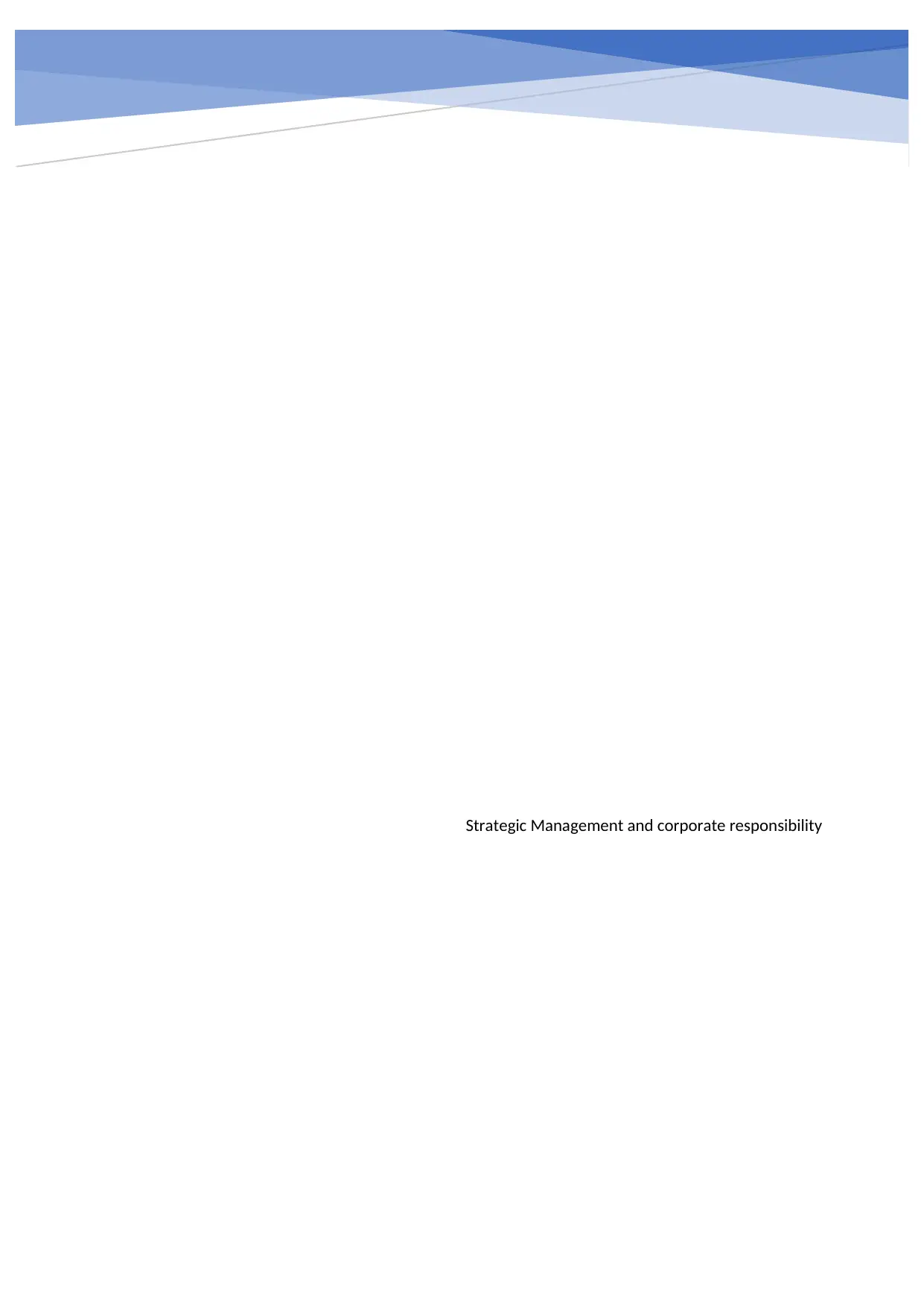
Strategic Management and corporate responsibility
Paraphrase This Document
Need a fresh take? Get an instant paraphrase of this document with our AI Paraphraser
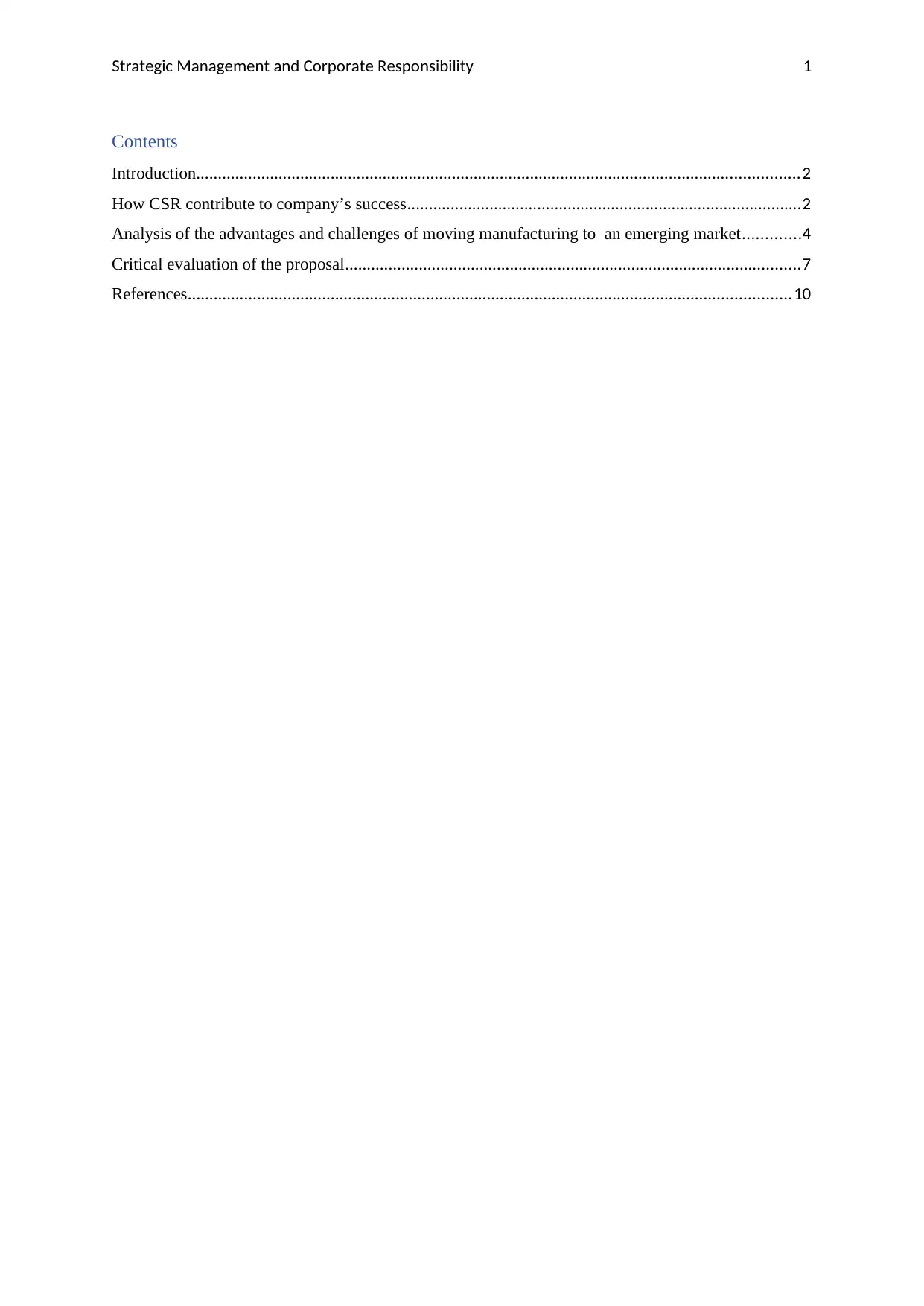
Strategic Management and Corporate Responsibility 1
Contents
Introduction...........................................................................................................................................2
How CSR contribute to company’s success...........................................................................................2
Analysis of the advantages and challenges of moving manufacturing to an emerging market.............4
Critical evaluation of the proposal.........................................................................................................7
References...........................................................................................................................................10
Contents
Introduction...........................................................................................................................................2
How CSR contribute to company’s success...........................................................................................2
Analysis of the advantages and challenges of moving manufacturing to an emerging market.............4
Critical evaluation of the proposal.........................................................................................................7
References...........................................................................................................................................10
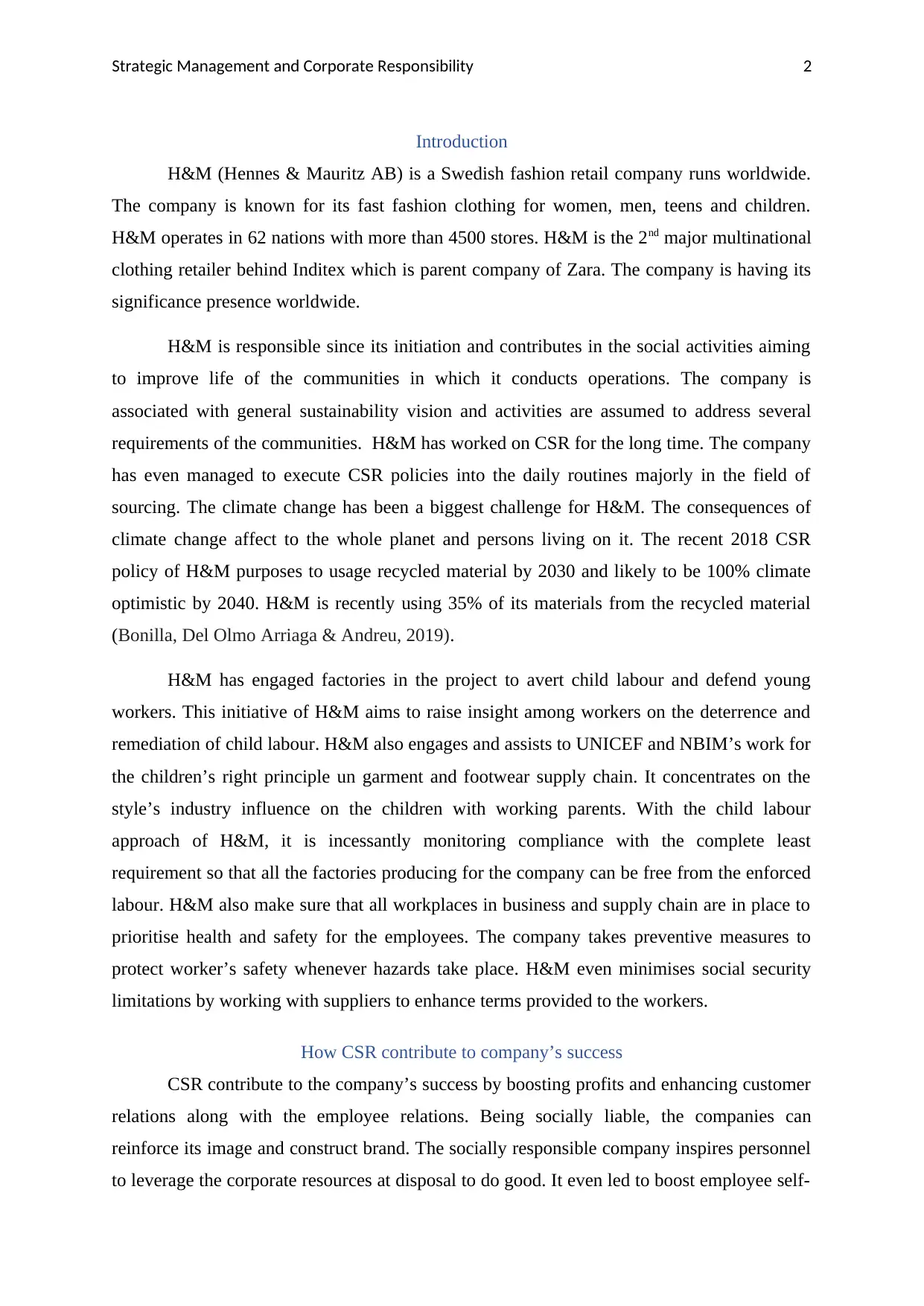
Strategic Management and Corporate Responsibility 2
Introduction
H&M (Hennes & Mauritz AB) is a Swedish fashion retail company runs worldwide.
The company is known for its fast fashion clothing for women, men, teens and children.
H&M operates in 62 nations with more than 4500 stores. H&M is the 2nd major multinational
clothing retailer behind Inditex which is parent company of Zara. The company is having its
significance presence worldwide.
H&M is responsible since its initiation and contributes in the social activities aiming
to improve life of the communities in which it conducts operations. The company is
associated with general sustainability vision and activities are assumed to address several
requirements of the communities. H&M has worked on CSR for the long time. The company
has even managed to execute CSR policies into the daily routines majorly in the field of
sourcing. The climate change has been a biggest challenge for H&M. The consequences of
climate change affect to the whole planet and persons living on it. The recent 2018 CSR
policy of H&M purposes to usage recycled material by 2030 and likely to be 100% climate
optimistic by 2040. H&M is recently using 35% of its materials from the recycled material
(Bonilla, Del Olmo Arriaga & Andreu, 2019).
H&M has engaged factories in the project to avert child labour and defend young
workers. This initiative of H&M aims to raise insight among workers on the deterrence and
remediation of child labour. H&M also engages and assists to UNICEF and NBIM’s work for
the children’s right principle un garment and footwear supply chain. It concentrates on the
style’s industry influence on the children with working parents. With the child labour
approach of H&M, it is incessantly monitoring compliance with the complete least
requirement so that all the factories producing for the company can be free from the enforced
labour. H&M also make sure that all workplaces in business and supply chain are in place to
prioritise health and safety for the employees. The company takes preventive measures to
protect worker’s safety whenever hazards take place. H&M even minimises social security
limitations by working with suppliers to enhance terms provided to the workers.
How CSR contribute to company’s success
CSR contribute to the company’s success by boosting profits and enhancing customer
relations along with the employee relations. Being socially liable, the companies can
reinforce its image and construct brand. The socially responsible company inspires personnel
to leverage the corporate resources at disposal to do good. It even led to boost employee self-
Introduction
H&M (Hennes & Mauritz AB) is a Swedish fashion retail company runs worldwide.
The company is known for its fast fashion clothing for women, men, teens and children.
H&M operates in 62 nations with more than 4500 stores. H&M is the 2nd major multinational
clothing retailer behind Inditex which is parent company of Zara. The company is having its
significance presence worldwide.
H&M is responsible since its initiation and contributes in the social activities aiming
to improve life of the communities in which it conducts operations. The company is
associated with general sustainability vision and activities are assumed to address several
requirements of the communities. H&M has worked on CSR for the long time. The company
has even managed to execute CSR policies into the daily routines majorly in the field of
sourcing. The climate change has been a biggest challenge for H&M. The consequences of
climate change affect to the whole planet and persons living on it. The recent 2018 CSR
policy of H&M purposes to usage recycled material by 2030 and likely to be 100% climate
optimistic by 2040. H&M is recently using 35% of its materials from the recycled material
(Bonilla, Del Olmo Arriaga & Andreu, 2019).
H&M has engaged factories in the project to avert child labour and defend young
workers. This initiative of H&M aims to raise insight among workers on the deterrence and
remediation of child labour. H&M also engages and assists to UNICEF and NBIM’s work for
the children’s right principle un garment and footwear supply chain. It concentrates on the
style’s industry influence on the children with working parents. With the child labour
approach of H&M, it is incessantly monitoring compliance with the complete least
requirement so that all the factories producing for the company can be free from the enforced
labour. H&M also make sure that all workplaces in business and supply chain are in place to
prioritise health and safety for the employees. The company takes preventive measures to
protect worker’s safety whenever hazards take place. H&M even minimises social security
limitations by working with suppliers to enhance terms provided to the workers.
How CSR contribute to company’s success
CSR contribute to the company’s success by boosting profits and enhancing customer
relations along with the employee relations. Being socially liable, the companies can
reinforce its image and construct brand. The socially responsible company inspires personnel
to leverage the corporate resources at disposal to do good. It even led to boost employee self-
⊘ This is a preview!⊘
Do you want full access?
Subscribe today to unlock all pages.

Trusted by 1+ million students worldwide
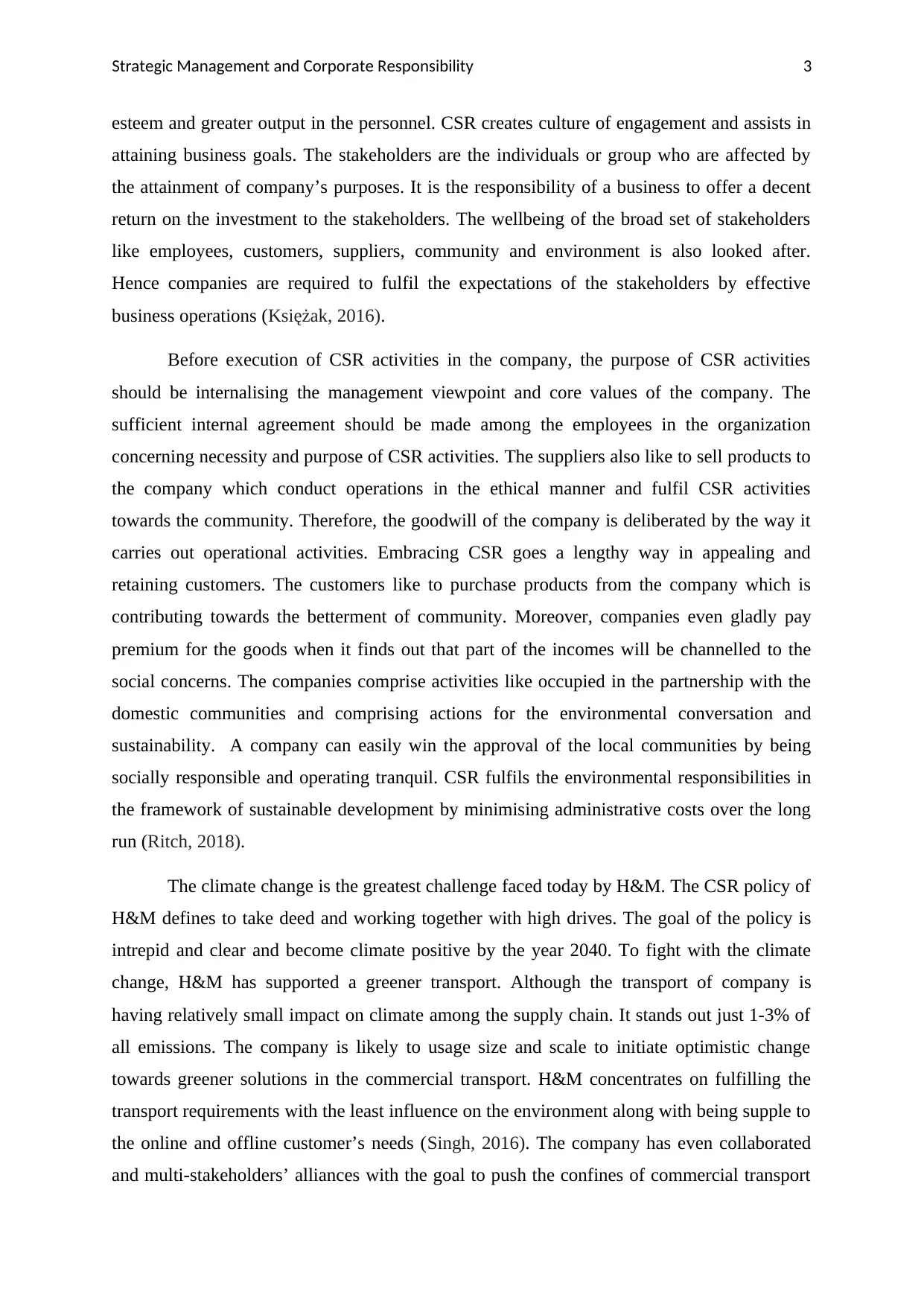
Strategic Management and Corporate Responsibility 3
esteem and greater output in the personnel. CSR creates culture of engagement and assists in
attaining business goals. The stakeholders are the individuals or group who are affected by
the attainment of company’s purposes. It is the responsibility of a business to offer a decent
return on the investment to the stakeholders. The wellbeing of the broad set of stakeholders
like employees, customers, suppliers, community and environment is also looked after.
Hence companies are required to fulfil the expectations of the stakeholders by effective
business operations (Księżak, 2016).
Before execution of CSR activities in the company, the purpose of CSR activities
should be internalising the management viewpoint and core values of the company. The
sufficient internal agreement should be made among the employees in the organization
concerning necessity and purpose of CSR activities. The suppliers also like to sell products to
the company which conduct operations in the ethical manner and fulfil CSR activities
towards the community. Therefore, the goodwill of the company is deliberated by the way it
carries out operational activities. Embracing CSR goes a lengthy way in appealing and
retaining customers. The customers like to purchase products from the company which is
contributing towards the betterment of community. Moreover, companies even gladly pay
premium for the goods when it finds out that part of the incomes will be channelled to the
social concerns. The companies comprise activities like occupied in the partnership with the
domestic communities and comprising actions for the environmental conversation and
sustainability. A company can easily win the approval of the local communities by being
socially responsible and operating tranquil. CSR fulfils the environmental responsibilities in
the framework of sustainable development by minimising administrative costs over the long
run (Ritch, 2018).
The climate change is the greatest challenge faced today by H&M. The CSR policy of
H&M defines to take deed and working together with high drives. The goal of the policy is
intrepid and clear and become climate positive by the year 2040. To fight with the climate
change, H&M has supported a greener transport. Although the transport of company is
having relatively small impact on climate among the supply chain. It stands out just 1-3% of
all emissions. The company is likely to usage size and scale to initiate optimistic change
towards greener solutions in the commercial transport. H&M concentrates on fulfilling the
transport requirements with the least influence on the environment along with being supple to
the online and offline customer’s needs (Singh, 2016). The company has even collaborated
and multi-stakeholders’ alliances with the goal to push the confines of commercial transport
esteem and greater output in the personnel. CSR creates culture of engagement and assists in
attaining business goals. The stakeholders are the individuals or group who are affected by
the attainment of company’s purposes. It is the responsibility of a business to offer a decent
return on the investment to the stakeholders. The wellbeing of the broad set of stakeholders
like employees, customers, suppliers, community and environment is also looked after.
Hence companies are required to fulfil the expectations of the stakeholders by effective
business operations (Księżak, 2016).
Before execution of CSR activities in the company, the purpose of CSR activities
should be internalising the management viewpoint and core values of the company. The
sufficient internal agreement should be made among the employees in the organization
concerning necessity and purpose of CSR activities. The suppliers also like to sell products to
the company which conduct operations in the ethical manner and fulfil CSR activities
towards the community. Therefore, the goodwill of the company is deliberated by the way it
carries out operational activities. Embracing CSR goes a lengthy way in appealing and
retaining customers. The customers like to purchase products from the company which is
contributing towards the betterment of community. Moreover, companies even gladly pay
premium for the goods when it finds out that part of the incomes will be channelled to the
social concerns. The companies comprise activities like occupied in the partnership with the
domestic communities and comprising actions for the environmental conversation and
sustainability. A company can easily win the approval of the local communities by being
socially responsible and operating tranquil. CSR fulfils the environmental responsibilities in
the framework of sustainable development by minimising administrative costs over the long
run (Ritch, 2018).
The climate change is the greatest challenge faced today by H&M. The CSR policy of
H&M defines to take deed and working together with high drives. The goal of the policy is
intrepid and clear and become climate positive by the year 2040. To fight with the climate
change, H&M has supported a greener transport. Although the transport of company is
having relatively small impact on climate among the supply chain. It stands out just 1-3% of
all emissions. The company is likely to usage size and scale to initiate optimistic change
towards greener solutions in the commercial transport. H&M concentrates on fulfilling the
transport requirements with the least influence on the environment along with being supple to
the online and offline customer’s needs (Singh, 2016). The company has even collaborated
and multi-stakeholders’ alliances with the goal to push the confines of commercial transport
Paraphrase This Document
Need a fresh take? Get an instant paraphrase of this document with our AI Paraphraser
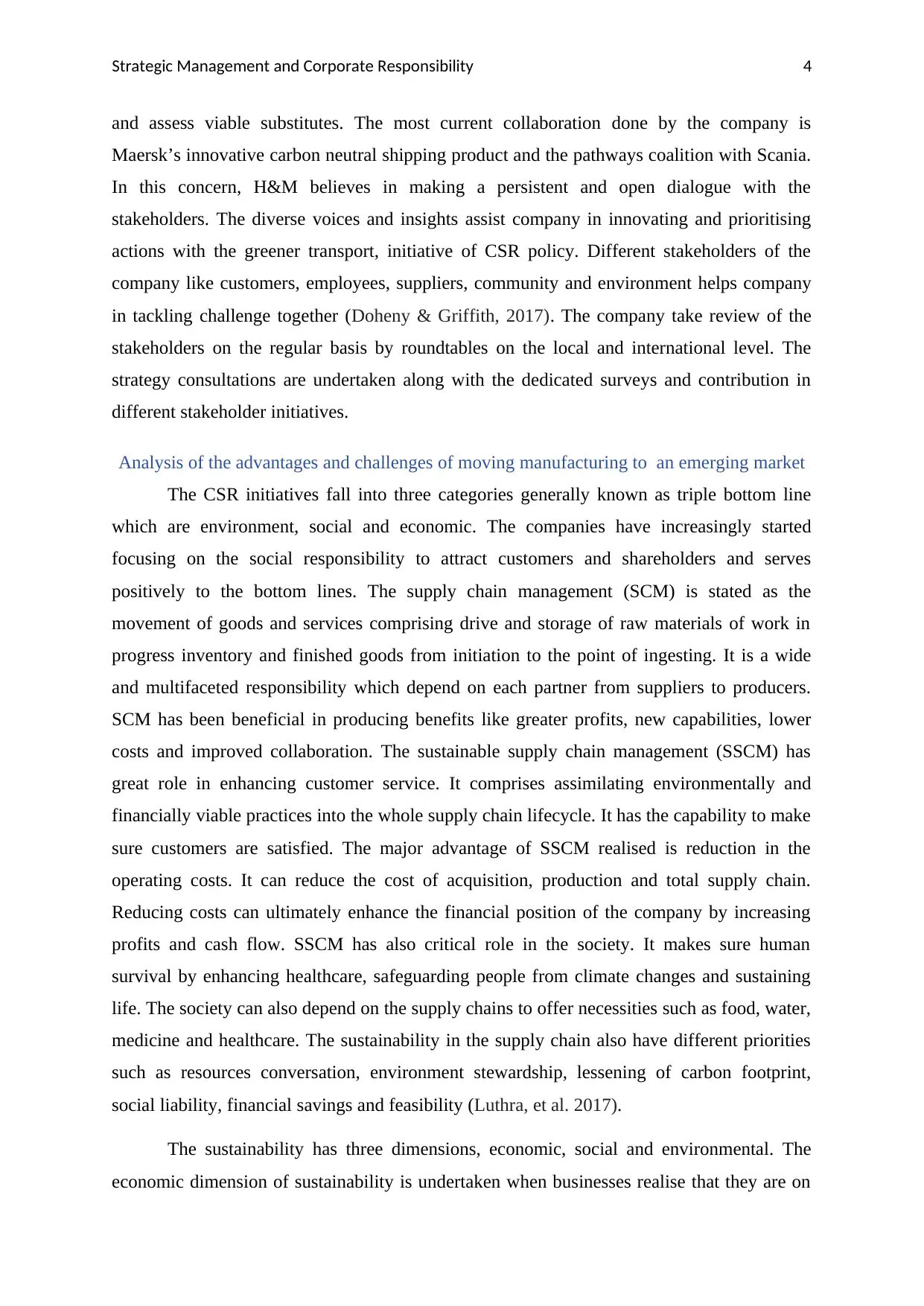
Strategic Management and Corporate Responsibility 4
and assess viable substitutes. The most current collaboration done by the company is
Maersk’s innovative carbon neutral shipping product and the pathways coalition with Scania.
In this concern, H&M believes in making a persistent and open dialogue with the
stakeholders. The diverse voices and insights assist company in innovating and prioritising
actions with the greener transport, initiative of CSR policy. Different stakeholders of the
company like customers, employees, suppliers, community and environment helps company
in tackling challenge together (Doheny & Griffith, 2017). The company take review of the
stakeholders on the regular basis by roundtables on the local and international level. The
strategy consultations are undertaken along with the dedicated surveys and contribution in
different stakeholder initiatives.
Analysis of the advantages and challenges of moving manufacturing to an emerging market
The CSR initiatives fall into three categories generally known as triple bottom line
which are environment, social and economic. The companies have increasingly started
focusing on the social responsibility to attract customers and shareholders and serves
positively to the bottom lines. The supply chain management (SCM) is stated as the
movement of goods and services comprising drive and storage of raw materials of work in
progress inventory and finished goods from initiation to the point of ingesting. It is a wide
and multifaceted responsibility which depend on each partner from suppliers to producers.
SCM has been beneficial in producing benefits like greater profits, new capabilities, lower
costs and improved collaboration. The sustainable supply chain management (SSCM) has
great role in enhancing customer service. It comprises assimilating environmentally and
financially viable practices into the whole supply chain lifecycle. It has the capability to make
sure customers are satisfied. The major advantage of SSCM realised is reduction in the
operating costs. It can reduce the cost of acquisition, production and total supply chain.
Reducing costs can ultimately enhance the financial position of the company by increasing
profits and cash flow. SSCM has also critical role in the society. It makes sure human
survival by enhancing healthcare, safeguarding people from climate changes and sustaining
life. The society can also depend on the supply chains to offer necessities such as food, water,
medicine and healthcare. The sustainability in the supply chain also have different priorities
such as resources conversation, environment stewardship, lessening of carbon footprint,
social liability, financial savings and feasibility (Luthra, et al. 2017).
The sustainability has three dimensions, economic, social and environmental. The
economic dimension of sustainability is undertaken when businesses realise that they are on
and assess viable substitutes. The most current collaboration done by the company is
Maersk’s innovative carbon neutral shipping product and the pathways coalition with Scania.
In this concern, H&M believes in making a persistent and open dialogue with the
stakeholders. The diverse voices and insights assist company in innovating and prioritising
actions with the greener transport, initiative of CSR policy. Different stakeholders of the
company like customers, employees, suppliers, community and environment helps company
in tackling challenge together (Doheny & Griffith, 2017). The company take review of the
stakeholders on the regular basis by roundtables on the local and international level. The
strategy consultations are undertaken along with the dedicated surveys and contribution in
different stakeholder initiatives.
Analysis of the advantages and challenges of moving manufacturing to an emerging market
The CSR initiatives fall into three categories generally known as triple bottom line
which are environment, social and economic. The companies have increasingly started
focusing on the social responsibility to attract customers and shareholders and serves
positively to the bottom lines. The supply chain management (SCM) is stated as the
movement of goods and services comprising drive and storage of raw materials of work in
progress inventory and finished goods from initiation to the point of ingesting. It is a wide
and multifaceted responsibility which depend on each partner from suppliers to producers.
SCM has been beneficial in producing benefits like greater profits, new capabilities, lower
costs and improved collaboration. The sustainable supply chain management (SSCM) has
great role in enhancing customer service. It comprises assimilating environmentally and
financially viable practices into the whole supply chain lifecycle. It has the capability to make
sure customers are satisfied. The major advantage of SSCM realised is reduction in the
operating costs. It can reduce the cost of acquisition, production and total supply chain.
Reducing costs can ultimately enhance the financial position of the company by increasing
profits and cash flow. SSCM has also critical role in the society. It makes sure human
survival by enhancing healthcare, safeguarding people from climate changes and sustaining
life. The society can also depend on the supply chains to offer necessities such as food, water,
medicine and healthcare. The sustainability in the supply chain also have different priorities
such as resources conversation, environment stewardship, lessening of carbon footprint,
social liability, financial savings and feasibility (Luthra, et al. 2017).
The sustainability has three dimensions, economic, social and environmental. The
economic dimension of sustainability is undertaken when businesses realise that they are on
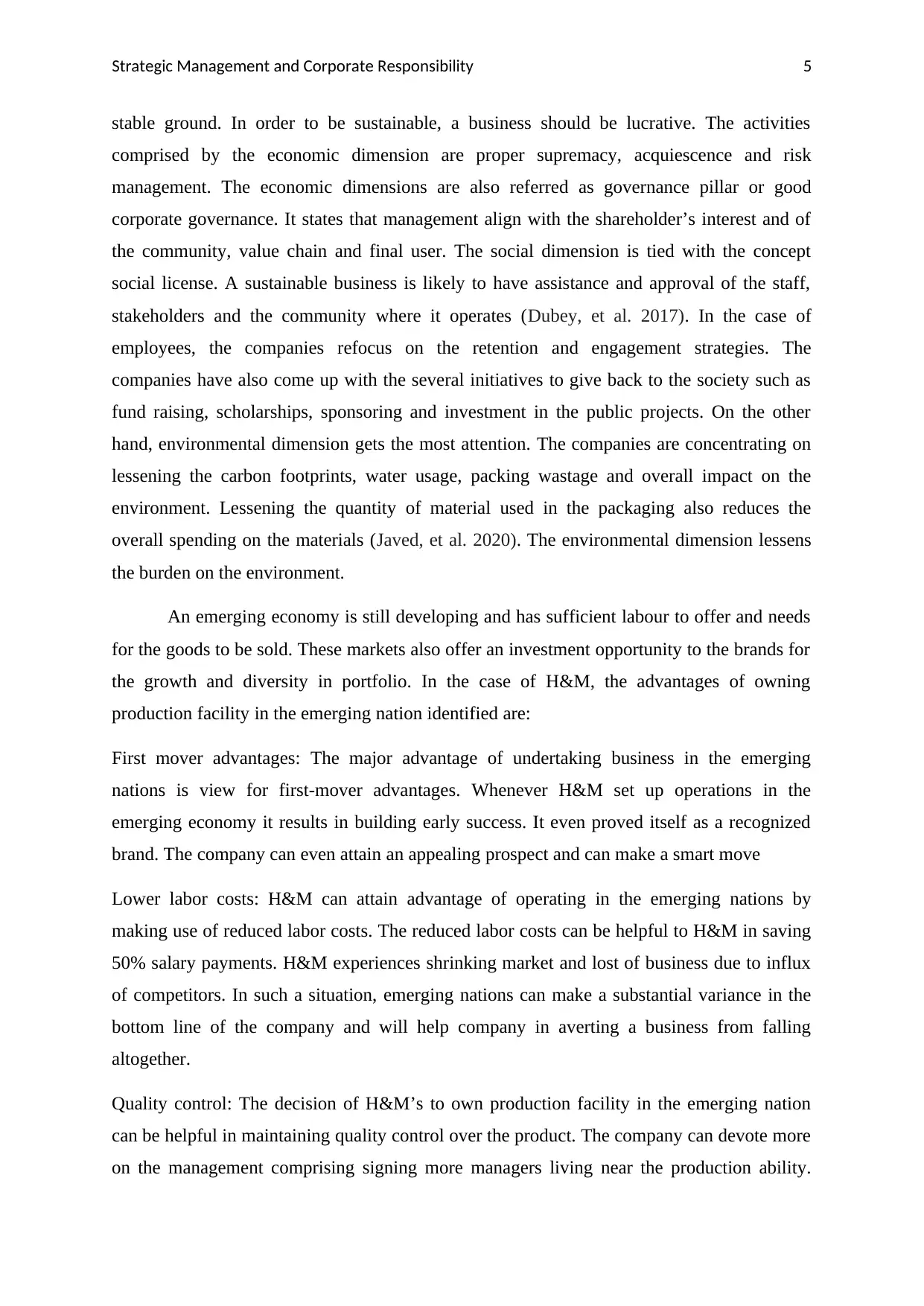
Strategic Management and Corporate Responsibility 5
stable ground. In order to be sustainable, a business should be lucrative. The activities
comprised by the economic dimension are proper supremacy, acquiescence and risk
management. The economic dimensions are also referred as governance pillar or good
corporate governance. It states that management align with the shareholder’s interest and of
the community, value chain and final user. The social dimension is tied with the concept
social license. A sustainable business is likely to have assistance and approval of the staff,
stakeholders and the community where it operates (Dubey, et al. 2017). In the case of
employees, the companies refocus on the retention and engagement strategies. The
companies have also come up with the several initiatives to give back to the society such as
fund raising, scholarships, sponsoring and investment in the public projects. On the other
hand, environmental dimension gets the most attention. The companies are concentrating on
lessening the carbon footprints, water usage, packing wastage and overall impact on the
environment. Lessening the quantity of material used in the packaging also reduces the
overall spending on the materials (Javed, et al. 2020). The environmental dimension lessens
the burden on the environment.
An emerging economy is still developing and has sufficient labour to offer and needs
for the goods to be sold. These markets also offer an investment opportunity to the brands for
the growth and diversity in portfolio. In the case of H&M, the advantages of owning
production facility in the emerging nation identified are:
First mover advantages: The major advantage of undertaking business in the emerging
nations is view for first-mover advantages. Whenever H&M set up operations in the
emerging economy it results in building early success. It even proved itself as a recognized
brand. The company can even attain an appealing prospect and can make a smart move
Lower labor costs: H&M can attain advantage of operating in the emerging nations by
making use of reduced labor costs. The reduced labor costs can be helpful to H&M in saving
50% salary payments. H&M experiences shrinking market and lost of business due to influx
of competitors. In such a situation, emerging nations can make a substantial variance in the
bottom line of the company and will help company in averting a business from falling
altogether.
Quality control: The decision of H&M’s to own production facility in the emerging nation
can be helpful in maintaining quality control over the product. The company can devote more
on the management comprising signing more managers living near the production ability.
stable ground. In order to be sustainable, a business should be lucrative. The activities
comprised by the economic dimension are proper supremacy, acquiescence and risk
management. The economic dimensions are also referred as governance pillar or good
corporate governance. It states that management align with the shareholder’s interest and of
the community, value chain and final user. The social dimension is tied with the concept
social license. A sustainable business is likely to have assistance and approval of the staff,
stakeholders and the community where it operates (Dubey, et al. 2017). In the case of
employees, the companies refocus on the retention and engagement strategies. The
companies have also come up with the several initiatives to give back to the society such as
fund raising, scholarships, sponsoring and investment in the public projects. On the other
hand, environmental dimension gets the most attention. The companies are concentrating on
lessening the carbon footprints, water usage, packing wastage and overall impact on the
environment. Lessening the quantity of material used in the packaging also reduces the
overall spending on the materials (Javed, et al. 2020). The environmental dimension lessens
the burden on the environment.
An emerging economy is still developing and has sufficient labour to offer and needs
for the goods to be sold. These markets also offer an investment opportunity to the brands for
the growth and diversity in portfolio. In the case of H&M, the advantages of owning
production facility in the emerging nation identified are:
First mover advantages: The major advantage of undertaking business in the emerging
nations is view for first-mover advantages. Whenever H&M set up operations in the
emerging economy it results in building early success. It even proved itself as a recognized
brand. The company can even attain an appealing prospect and can make a smart move
Lower labor costs: H&M can attain advantage of operating in the emerging nations by
making use of reduced labor costs. The reduced labor costs can be helpful to H&M in saving
50% salary payments. H&M experiences shrinking market and lost of business due to influx
of competitors. In such a situation, emerging nations can make a substantial variance in the
bottom line of the company and will help company in averting a business from falling
altogether.
Quality control: The decision of H&M’s to own production facility in the emerging nation
can be helpful in maintaining quality control over the product. The company can devote more
on the management comprising signing more managers living near the production ability.
⊘ This is a preview!⊘
Do you want full access?
Subscribe today to unlock all pages.

Trusted by 1+ million students worldwide
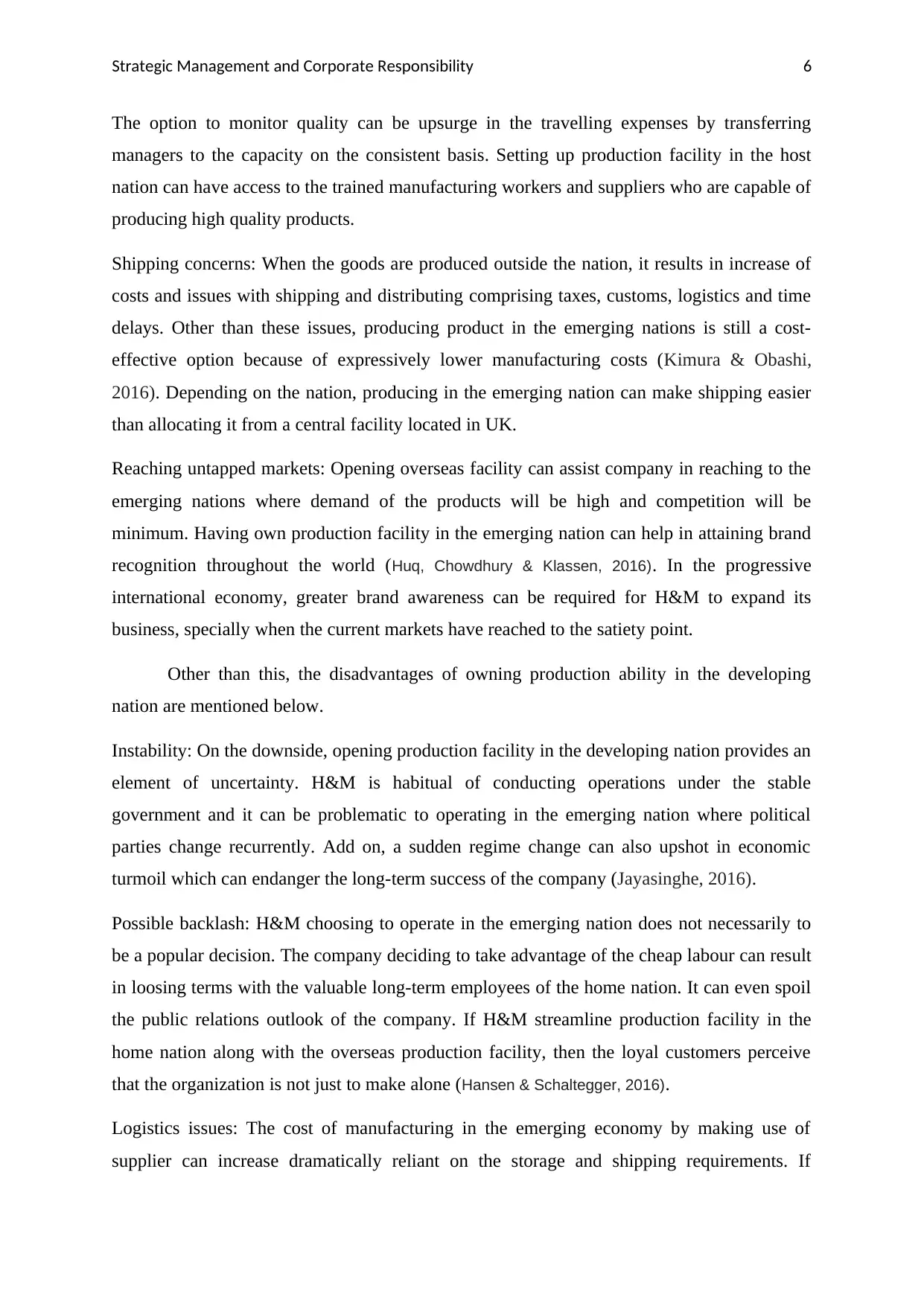
Strategic Management and Corporate Responsibility 6
The option to monitor quality can be upsurge in the travelling expenses by transferring
managers to the capacity on the consistent basis. Setting up production facility in the host
nation can have access to the trained manufacturing workers and suppliers who are capable of
producing high quality products.
Shipping concerns: When the goods are produced outside the nation, it results in increase of
costs and issues with shipping and distributing comprising taxes, customs, logistics and time
delays. Other than these issues, producing product in the emerging nations is still a cost-
effective option because of expressively lower manufacturing costs (Kimura & Obashi,
2016). Depending on the nation, producing in the emerging nation can make shipping easier
than allocating it from a central facility located in UK.
Reaching untapped markets: Opening overseas facility can assist company in reaching to the
emerging nations where demand of the products will be high and competition will be
minimum. Having own production facility in the emerging nation can help in attaining brand
recognition throughout the world (Huq, Chowdhury & Klassen, 2016). In the progressive
international economy, greater brand awareness can be required for H&M to expand its
business, specially when the current markets have reached to the satiety point.
Other than this, the disadvantages of owning production ability in the developing
nation are mentioned below.
Instability: On the downside, opening production facility in the developing nation provides an
element of uncertainty. H&M is habitual of conducting operations under the stable
government and it can be problematic to operating in the emerging nation where political
parties change recurrently. Add on, a sudden regime change can also upshot in economic
turmoil which can endanger the long-term success of the company (Jayasinghe, 2016).
Possible backlash: H&M choosing to operate in the emerging nation does not necessarily to
be a popular decision. The company deciding to take advantage of the cheap labour can result
in loosing terms with the valuable long-term employees of the home nation. It can even spoil
the public relations outlook of the company. If H&M streamline production facility in the
home nation along with the overseas production facility, then the loyal customers perceive
that the organization is not just to make alone (Hansen & Schaltegger, 2016).
Logistics issues: The cost of manufacturing in the emerging economy by making use of
supplier can increase dramatically reliant on the storage and shipping requirements. If
The option to monitor quality can be upsurge in the travelling expenses by transferring
managers to the capacity on the consistent basis. Setting up production facility in the host
nation can have access to the trained manufacturing workers and suppliers who are capable of
producing high quality products.
Shipping concerns: When the goods are produced outside the nation, it results in increase of
costs and issues with shipping and distributing comprising taxes, customs, logistics and time
delays. Other than these issues, producing product in the emerging nations is still a cost-
effective option because of expressively lower manufacturing costs (Kimura & Obashi,
2016). Depending on the nation, producing in the emerging nation can make shipping easier
than allocating it from a central facility located in UK.
Reaching untapped markets: Opening overseas facility can assist company in reaching to the
emerging nations where demand of the products will be high and competition will be
minimum. Having own production facility in the emerging nation can help in attaining brand
recognition throughout the world (Huq, Chowdhury & Klassen, 2016). In the progressive
international economy, greater brand awareness can be required for H&M to expand its
business, specially when the current markets have reached to the satiety point.
Other than this, the disadvantages of owning production ability in the developing
nation are mentioned below.
Instability: On the downside, opening production facility in the developing nation provides an
element of uncertainty. H&M is habitual of conducting operations under the stable
government and it can be problematic to operating in the emerging nation where political
parties change recurrently. Add on, a sudden regime change can also upshot in economic
turmoil which can endanger the long-term success of the company (Jayasinghe, 2016).
Possible backlash: H&M choosing to operate in the emerging nation does not necessarily to
be a popular decision. The company deciding to take advantage of the cheap labour can result
in loosing terms with the valuable long-term employees of the home nation. It can even spoil
the public relations outlook of the company. If H&M streamline production facility in the
home nation along with the overseas production facility, then the loyal customers perceive
that the organization is not just to make alone (Hansen & Schaltegger, 2016).
Logistics issues: The cost of manufacturing in the emerging economy by making use of
supplier can increase dramatically reliant on the storage and shipping requirements. If
Paraphrase This Document
Need a fresh take? Get an instant paraphrase of this document with our AI Paraphraser
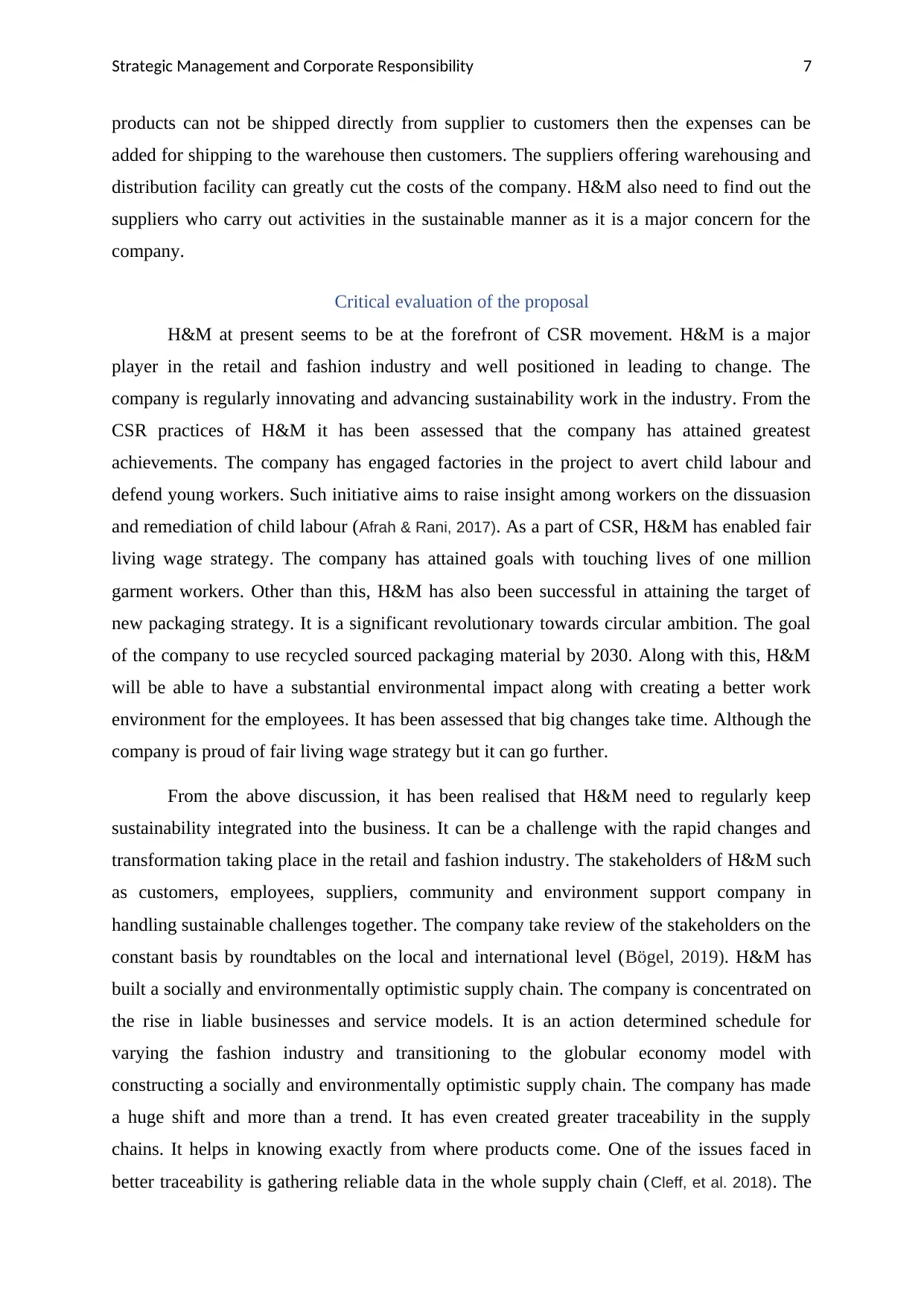
Strategic Management and Corporate Responsibility 7
products can not be shipped directly from supplier to customers then the expenses can be
added for shipping to the warehouse then customers. The suppliers offering warehousing and
distribution facility can greatly cut the costs of the company. H&M also need to find out the
suppliers who carry out activities in the sustainable manner as it is a major concern for the
company.
Critical evaluation of the proposal
H&M at present seems to be at the forefront of CSR movement. H&M is a major
player in the retail and fashion industry and well positioned in leading to change. The
company is regularly innovating and advancing sustainability work in the industry. From the
CSR practices of H&M it has been assessed that the company has attained greatest
achievements. The company has engaged factories in the project to avert child labour and
defend young workers. Such initiative aims to raise insight among workers on the dissuasion
and remediation of child labour (Afrah & Rani, 2017). As a part of CSR, H&M has enabled fair
living wage strategy. The company has attained goals with touching lives of one million
garment workers. Other than this, H&M has also been successful in attaining the target of
new packaging strategy. It is a significant revolutionary towards circular ambition. The goal
of the company to use recycled sourced packaging material by 2030. Along with this, H&M
will be able to have a substantial environmental impact along with creating a better work
environment for the employees. It has been assessed that big changes take time. Although the
company is proud of fair living wage strategy but it can go further.
From the above discussion, it has been realised that H&M need to regularly keep
sustainability integrated into the business. It can be a challenge with the rapid changes and
transformation taking place in the retail and fashion industry. The stakeholders of H&M such
as customers, employees, suppliers, community and environment support company in
handling sustainable challenges together. The company take review of the stakeholders on the
constant basis by roundtables on the local and international level (Bögel, 2019). H&M has
built a socially and environmentally optimistic supply chain. The company is concentrated on
the rise in liable businesses and service models. It is an action determined schedule for
varying the fashion industry and transitioning to the globular economy model with
constructing a socially and environmentally optimistic supply chain. The company has made
a huge shift and more than a trend. It has even created greater traceability in the supply
chains. It helps in knowing exactly from where products come. One of the issues faced in
better traceability is gathering reliable data in the whole supply chain (Cleff, et al. 2018). The
products can not be shipped directly from supplier to customers then the expenses can be
added for shipping to the warehouse then customers. The suppliers offering warehousing and
distribution facility can greatly cut the costs of the company. H&M also need to find out the
suppliers who carry out activities in the sustainable manner as it is a major concern for the
company.
Critical evaluation of the proposal
H&M at present seems to be at the forefront of CSR movement. H&M is a major
player in the retail and fashion industry and well positioned in leading to change. The
company is regularly innovating and advancing sustainability work in the industry. From the
CSR practices of H&M it has been assessed that the company has attained greatest
achievements. The company has engaged factories in the project to avert child labour and
defend young workers. Such initiative aims to raise insight among workers on the dissuasion
and remediation of child labour (Afrah & Rani, 2017). As a part of CSR, H&M has enabled fair
living wage strategy. The company has attained goals with touching lives of one million
garment workers. Other than this, H&M has also been successful in attaining the target of
new packaging strategy. It is a significant revolutionary towards circular ambition. The goal
of the company to use recycled sourced packaging material by 2030. Along with this, H&M
will be able to have a substantial environmental impact along with creating a better work
environment for the employees. It has been assessed that big changes take time. Although the
company is proud of fair living wage strategy but it can go further.
From the above discussion, it has been realised that H&M need to regularly keep
sustainability integrated into the business. It can be a challenge with the rapid changes and
transformation taking place in the retail and fashion industry. The stakeholders of H&M such
as customers, employees, suppliers, community and environment support company in
handling sustainable challenges together. The company take review of the stakeholders on the
constant basis by roundtables on the local and international level (Bögel, 2019). H&M has
built a socially and environmentally optimistic supply chain. The company is concentrated on
the rise in liable businesses and service models. It is an action determined schedule for
varying the fashion industry and transitioning to the globular economy model with
constructing a socially and environmentally optimistic supply chain. The company has made
a huge shift and more than a trend. It has even created greater traceability in the supply
chains. It helps in knowing exactly from where products come. One of the issues faced in
better traceability is gathering reliable data in the whole supply chain (Cleff, et al. 2018). The
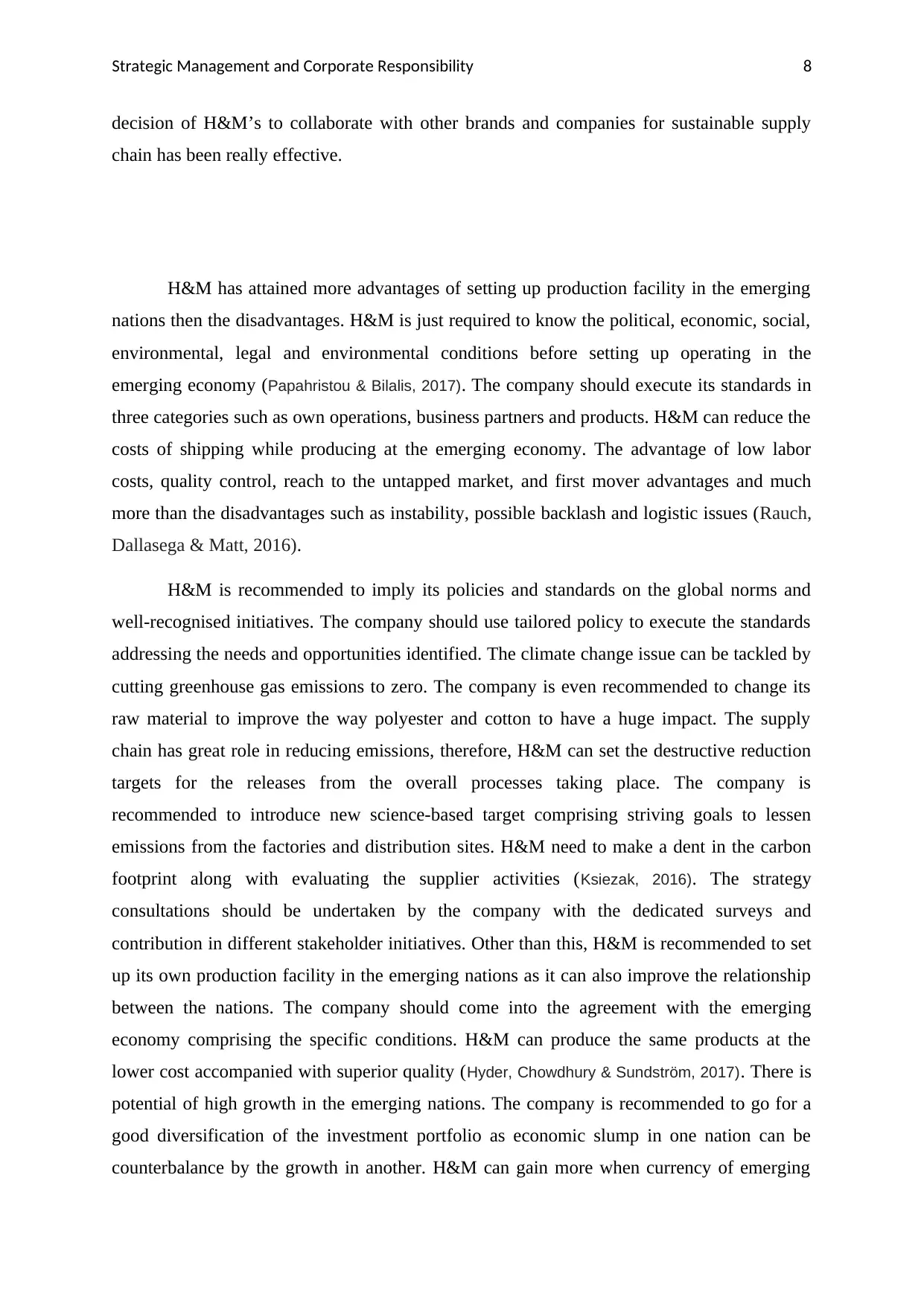
Strategic Management and Corporate Responsibility 8
decision of H&M’s to collaborate with other brands and companies for sustainable supply
chain has been really effective.
H&M has attained more advantages of setting up production facility in the emerging
nations then the disadvantages. H&M is just required to know the political, economic, social,
environmental, legal and environmental conditions before setting up operating in the
emerging economy (Papahristou & Bilalis, 2017). The company should execute its standards in
three categories such as own operations, business partners and products. H&M can reduce the
costs of shipping while producing at the emerging economy. The advantage of low labor
costs, quality control, reach to the untapped market, and first mover advantages and much
more than the disadvantages such as instability, possible backlash and logistic issues (Rauch,
Dallasega & Matt, 2016).
H&M is recommended to imply its policies and standards on the global norms and
well-recognised initiatives. The company should use tailored policy to execute the standards
addressing the needs and opportunities identified. The climate change issue can be tackled by
cutting greenhouse gas emissions to zero. The company is even recommended to change its
raw material to improve the way polyester and cotton to have a huge impact. The supply
chain has great role in reducing emissions, therefore, H&M can set the destructive reduction
targets for the releases from the overall processes taking place. The company is
recommended to introduce new science-based target comprising striving goals to lessen
emissions from the factories and distribution sites. H&M need to make a dent in the carbon
footprint along with evaluating the supplier activities (Ksiezak, 2016). The strategy
consultations should be undertaken by the company with the dedicated surveys and
contribution in different stakeholder initiatives. Other than this, H&M is recommended to set
up its own production facility in the emerging nations as it can also improve the relationship
between the nations. The company should come into the agreement with the emerging
economy comprising the specific conditions. H&M can produce the same products at the
lower cost accompanied with superior quality (Hyder, Chowdhury & Sundström, 2017). There is
potential of high growth in the emerging nations. The company is recommended to go for a
good diversification of the investment portfolio as economic slump in one nation can be
counterbalance by the growth in another. H&M can gain more when currency of emerging
decision of H&M’s to collaborate with other brands and companies for sustainable supply
chain has been really effective.
H&M has attained more advantages of setting up production facility in the emerging
nations then the disadvantages. H&M is just required to know the political, economic, social,
environmental, legal and environmental conditions before setting up operating in the
emerging economy (Papahristou & Bilalis, 2017). The company should execute its standards in
three categories such as own operations, business partners and products. H&M can reduce the
costs of shipping while producing at the emerging economy. The advantage of low labor
costs, quality control, reach to the untapped market, and first mover advantages and much
more than the disadvantages such as instability, possible backlash and logistic issues (Rauch,
Dallasega & Matt, 2016).
H&M is recommended to imply its policies and standards on the global norms and
well-recognised initiatives. The company should use tailored policy to execute the standards
addressing the needs and opportunities identified. The climate change issue can be tackled by
cutting greenhouse gas emissions to zero. The company is even recommended to change its
raw material to improve the way polyester and cotton to have a huge impact. The supply
chain has great role in reducing emissions, therefore, H&M can set the destructive reduction
targets for the releases from the overall processes taking place. The company is
recommended to introduce new science-based target comprising striving goals to lessen
emissions from the factories and distribution sites. H&M need to make a dent in the carbon
footprint along with evaluating the supplier activities (Ksiezak, 2016). The strategy
consultations should be undertaken by the company with the dedicated surveys and
contribution in different stakeholder initiatives. Other than this, H&M is recommended to set
up its own production facility in the emerging nations as it can also improve the relationship
between the nations. The company should come into the agreement with the emerging
economy comprising the specific conditions. H&M can produce the same products at the
lower cost accompanied with superior quality (Hyder, Chowdhury & Sundström, 2017). There is
potential of high growth in the emerging nations. The company is recommended to go for a
good diversification of the investment portfolio as economic slump in one nation can be
counterbalance by the growth in another. H&M can gain more when currency of emerging
⊘ This is a preview!⊘
Do you want full access?
Subscribe today to unlock all pages.

Trusted by 1+ million students worldwide
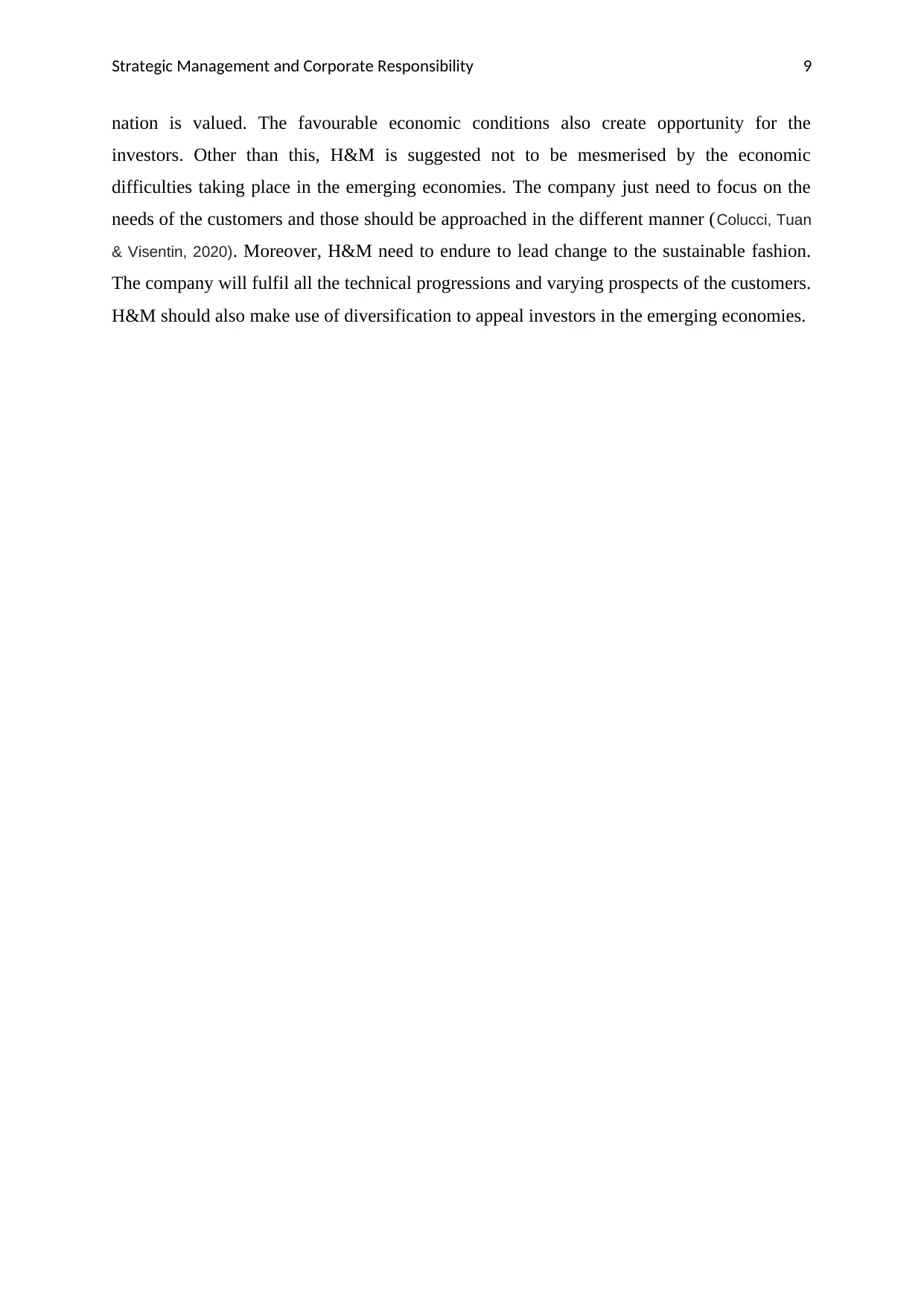
Strategic Management and Corporate Responsibility 9
nation is valued. The favourable economic conditions also create opportunity for the
investors. Other than this, H&M is suggested not to be mesmerised by the economic
difficulties taking place in the emerging economies. The company just need to focus on the
needs of the customers and those should be approached in the different manner (Colucci, Tuan
& Visentin, 2020). Moreover, H&M need to endure to lead change to the sustainable fashion.
The company will fulfil all the technical progressions and varying prospects of the customers.
H&M should also make use of diversification to appeal investors in the emerging economies.
nation is valued. The favourable economic conditions also create opportunity for the
investors. Other than this, H&M is suggested not to be mesmerised by the economic
difficulties taking place in the emerging economies. The company just need to focus on the
needs of the customers and those should be approached in the different manner (Colucci, Tuan
& Visentin, 2020). Moreover, H&M need to endure to lead change to the sustainable fashion.
The company will fulfil all the technical progressions and varying prospects of the customers.
H&M should also make use of diversification to appeal investors in the emerging economies.
Paraphrase This Document
Need a fresh take? Get an instant paraphrase of this document with our AI Paraphraser
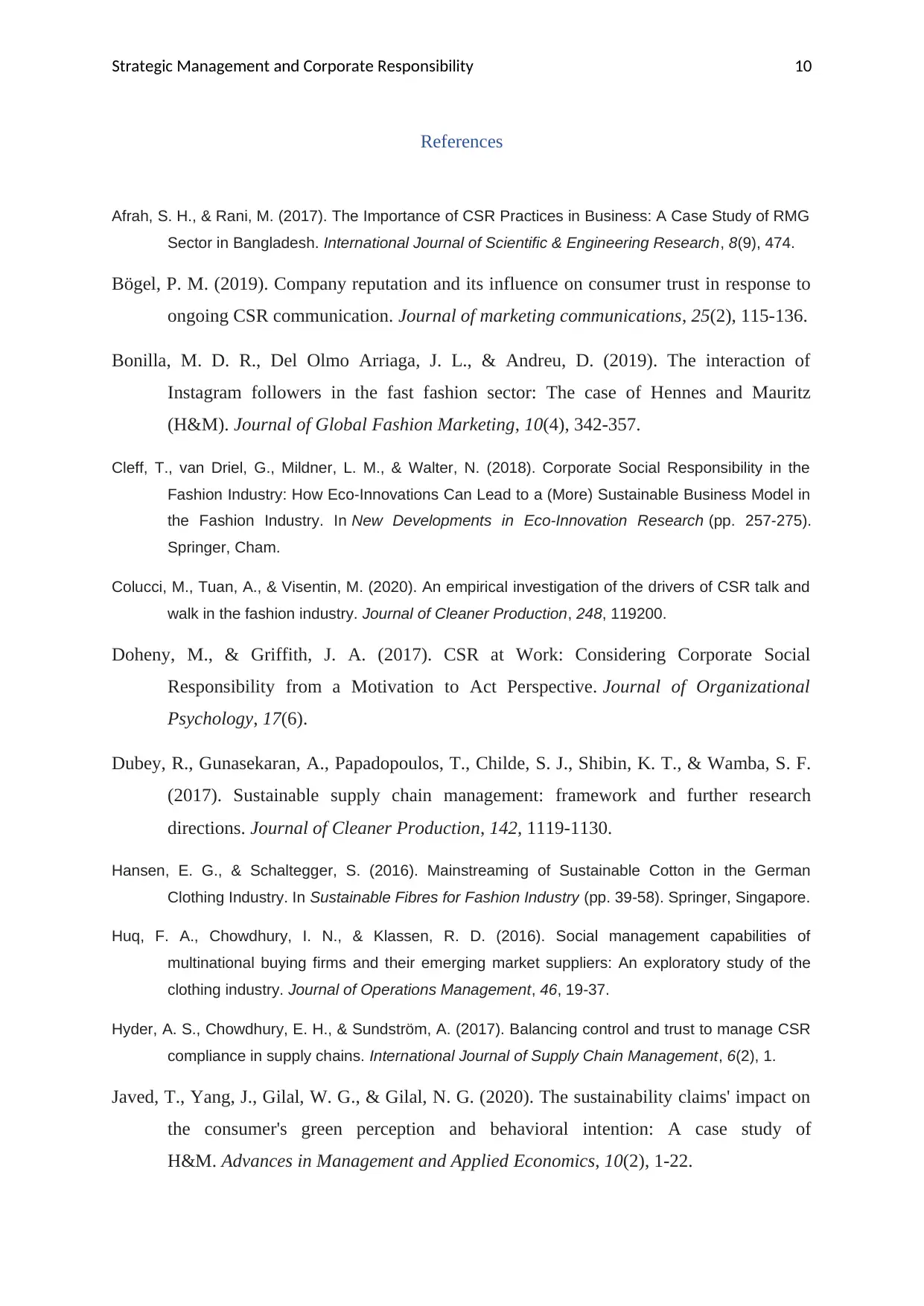
Strategic Management and Corporate Responsibility 10
References
Afrah, S. H., & Rani, M. (2017). The Importance of CSR Practices in Business: A Case Study of RMG
Sector in Bangladesh. International Journal of Scientific & Engineering Research, 8(9), 474.
Bögel, P. M. (2019). Company reputation and its influence on consumer trust in response to
ongoing CSR communication. Journal of marketing communications, 25(2), 115-136.
Bonilla, M. D. R., Del Olmo Arriaga, J. L., & Andreu, D. (2019). The interaction of
Instagram followers in the fast fashion sector: The case of Hennes and Mauritz
(H&M). Journal of Global Fashion Marketing, 10(4), 342-357.
Cleff, T., van Driel, G., Mildner, L. M., & Walter, N. (2018). Corporate Social Responsibility in the
Fashion Industry: How Eco-Innovations Can Lead to a (More) Sustainable Business Model in
the Fashion Industry. In New Developments in Eco-Innovation Research (pp. 257-275).
Springer, Cham.
Colucci, M., Tuan, A., & Visentin, M. (2020). An empirical investigation of the drivers of CSR talk and
walk in the fashion industry. Journal of Cleaner Production, 248, 119200.
Doheny, M., & Griffith, J. A. (2017). CSR at Work: Considering Corporate Social
Responsibility from a Motivation to Act Perspective. Journal of Organizational
Psychology, 17(6).
Dubey, R., Gunasekaran, A., Papadopoulos, T., Childe, S. J., Shibin, K. T., & Wamba, S. F.
(2017). Sustainable supply chain management: framework and further research
directions. Journal of Cleaner Production, 142, 1119-1130.
Hansen, E. G., & Schaltegger, S. (2016). Mainstreaming of Sustainable Cotton in the German
Clothing Industry. In Sustainable Fibres for Fashion Industry (pp. 39-58). Springer, Singapore.
Huq, F. A., Chowdhury, I. N., & Klassen, R. D. (2016). Social management capabilities of
multinational buying firms and their emerging market suppliers: An exploratory study of the
clothing industry. Journal of Operations Management, 46, 19-37.
Hyder, A. S., Chowdhury, E. H., & Sundström, A. (2017). Balancing control and trust to manage CSR
compliance in supply chains. International Journal of Supply Chain Management, 6(2), 1.
Javed, T., Yang, J., Gilal, W. G., & Gilal, N. G. (2020). The sustainability claims' impact on
the consumer's green perception and behavioral intention: A case study of
H&M. Advances in Management and Applied Economics, 10(2), 1-22.
References
Afrah, S. H., & Rani, M. (2017). The Importance of CSR Practices in Business: A Case Study of RMG
Sector in Bangladesh. International Journal of Scientific & Engineering Research, 8(9), 474.
Bögel, P. M. (2019). Company reputation and its influence on consumer trust in response to
ongoing CSR communication. Journal of marketing communications, 25(2), 115-136.
Bonilla, M. D. R., Del Olmo Arriaga, J. L., & Andreu, D. (2019). The interaction of
Instagram followers in the fast fashion sector: The case of Hennes and Mauritz
(H&M). Journal of Global Fashion Marketing, 10(4), 342-357.
Cleff, T., van Driel, G., Mildner, L. M., & Walter, N. (2018). Corporate Social Responsibility in the
Fashion Industry: How Eco-Innovations Can Lead to a (More) Sustainable Business Model in
the Fashion Industry. In New Developments in Eco-Innovation Research (pp. 257-275).
Springer, Cham.
Colucci, M., Tuan, A., & Visentin, M. (2020). An empirical investigation of the drivers of CSR talk and
walk in the fashion industry. Journal of Cleaner Production, 248, 119200.
Doheny, M., & Griffith, J. A. (2017). CSR at Work: Considering Corporate Social
Responsibility from a Motivation to Act Perspective. Journal of Organizational
Psychology, 17(6).
Dubey, R., Gunasekaran, A., Papadopoulos, T., Childe, S. J., Shibin, K. T., & Wamba, S. F.
(2017). Sustainable supply chain management: framework and further research
directions. Journal of Cleaner Production, 142, 1119-1130.
Hansen, E. G., & Schaltegger, S. (2016). Mainstreaming of Sustainable Cotton in the German
Clothing Industry. In Sustainable Fibres for Fashion Industry (pp. 39-58). Springer, Singapore.
Huq, F. A., Chowdhury, I. N., & Klassen, R. D. (2016). Social management capabilities of
multinational buying firms and their emerging market suppliers: An exploratory study of the
clothing industry. Journal of Operations Management, 46, 19-37.
Hyder, A. S., Chowdhury, E. H., & Sundström, A. (2017). Balancing control and trust to manage CSR
compliance in supply chains. International Journal of Supply Chain Management, 6(2), 1.
Javed, T., Yang, J., Gilal, W. G., & Gilal, N. G. (2020). The sustainability claims' impact on
the consumer's green perception and behavioral intention: A case study of
H&M. Advances in Management and Applied Economics, 10(2), 1-22.
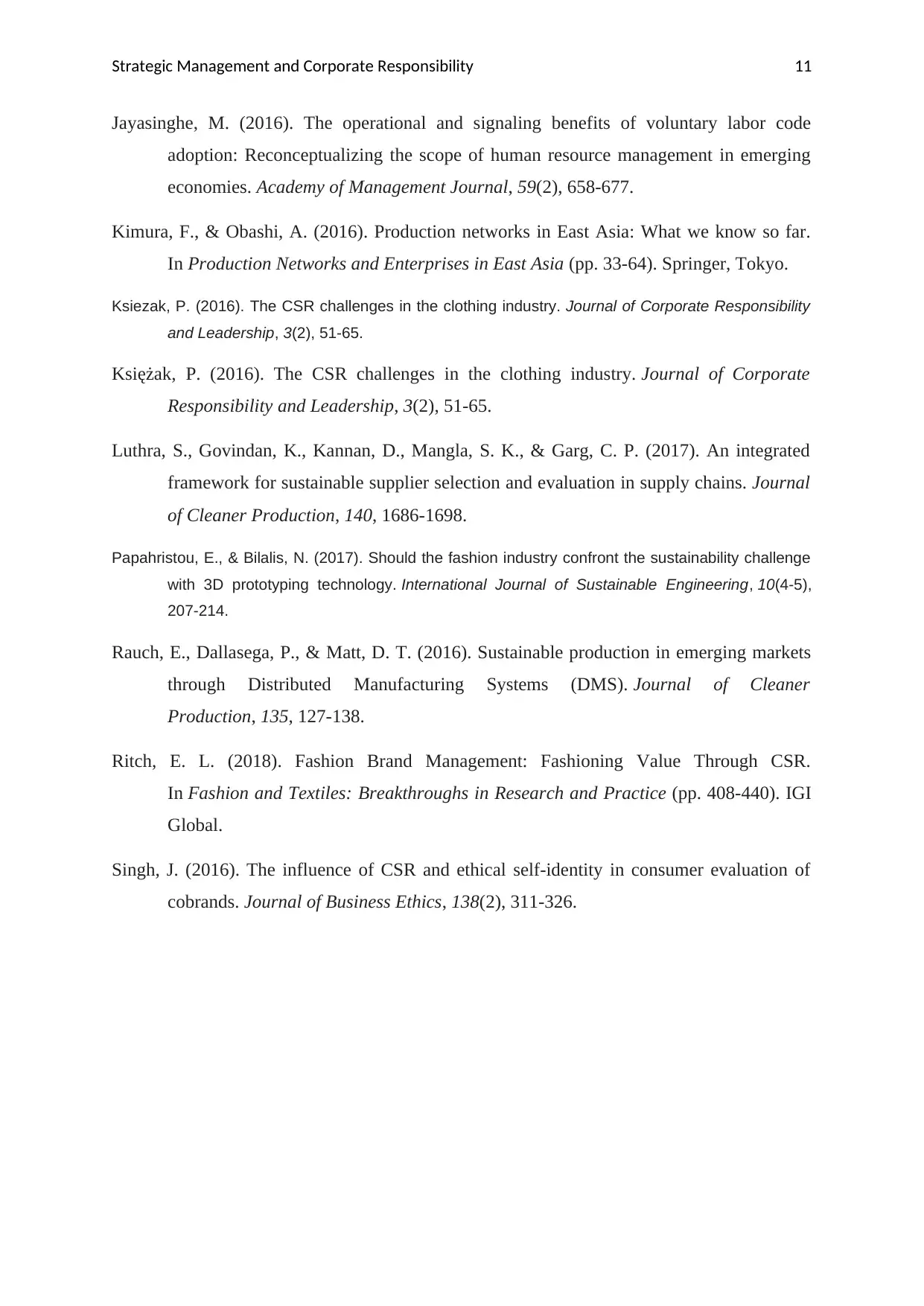
Strategic Management and Corporate Responsibility 11
Jayasinghe, M. (2016). The operational and signaling benefits of voluntary labor code
adoption: Reconceptualizing the scope of human resource management in emerging
economies. Academy of Management Journal, 59(2), 658-677.
Kimura, F., & Obashi, A. (2016). Production networks in East Asia: What we know so far.
In Production Networks and Enterprises in East Asia (pp. 33-64). Springer, Tokyo.
Ksiezak, P. (2016). The CSR challenges in the clothing industry. Journal of Corporate Responsibility
and Leadership, 3(2), 51-65.
Księżak, P. (2016). The CSR challenges in the clothing industry. Journal of Corporate
Responsibility and Leadership, 3(2), 51-65.
Luthra, S., Govindan, K., Kannan, D., Mangla, S. K., & Garg, C. P. (2017). An integrated
framework for sustainable supplier selection and evaluation in supply chains. Journal
of Cleaner Production, 140, 1686-1698.
Papahristou, E., & Bilalis, N. (2017). Should the fashion industry confront the sustainability challenge
with 3D prototyping technology. International Journal of Sustainable Engineering, 10(4-5),
207-214.
Rauch, E., Dallasega, P., & Matt, D. T. (2016). Sustainable production in emerging markets
through Distributed Manufacturing Systems (DMS). Journal of Cleaner
Production, 135, 127-138.
Ritch, E. L. (2018). Fashion Brand Management: Fashioning Value Through CSR.
In Fashion and Textiles: Breakthroughs in Research and Practice (pp. 408-440). IGI
Global.
Singh, J. (2016). The influence of CSR and ethical self-identity in consumer evaluation of
cobrands. Journal of Business Ethics, 138(2), 311-326.
Jayasinghe, M. (2016). The operational and signaling benefits of voluntary labor code
adoption: Reconceptualizing the scope of human resource management in emerging
economies. Academy of Management Journal, 59(2), 658-677.
Kimura, F., & Obashi, A. (2016). Production networks in East Asia: What we know so far.
In Production Networks and Enterprises in East Asia (pp. 33-64). Springer, Tokyo.
Ksiezak, P. (2016). The CSR challenges in the clothing industry. Journal of Corporate Responsibility
and Leadership, 3(2), 51-65.
Księżak, P. (2016). The CSR challenges in the clothing industry. Journal of Corporate
Responsibility and Leadership, 3(2), 51-65.
Luthra, S., Govindan, K., Kannan, D., Mangla, S. K., & Garg, C. P. (2017). An integrated
framework for sustainable supplier selection and evaluation in supply chains. Journal
of Cleaner Production, 140, 1686-1698.
Papahristou, E., & Bilalis, N. (2017). Should the fashion industry confront the sustainability challenge
with 3D prototyping technology. International Journal of Sustainable Engineering, 10(4-5),
207-214.
Rauch, E., Dallasega, P., & Matt, D. T. (2016). Sustainable production in emerging markets
through Distributed Manufacturing Systems (DMS). Journal of Cleaner
Production, 135, 127-138.
Ritch, E. L. (2018). Fashion Brand Management: Fashioning Value Through CSR.
In Fashion and Textiles: Breakthroughs in Research and Practice (pp. 408-440). IGI
Global.
Singh, J. (2016). The influence of CSR and ethical self-identity in consumer evaluation of
cobrands. Journal of Business Ethics, 138(2), 311-326.
⊘ This is a preview!⊘
Do you want full access?
Subscribe today to unlock all pages.

Trusted by 1+ million students worldwide
1 out of 12
Related Documents
Your All-in-One AI-Powered Toolkit for Academic Success.
+13062052269
info@desklib.com
Available 24*7 on WhatsApp / Email
![[object Object]](/_next/static/media/star-bottom.7253800d.svg)
Unlock your academic potential
Copyright © 2020–2025 A2Z Services. All Rights Reserved. Developed and managed by ZUCOL.





